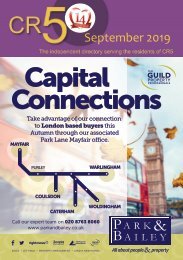You also want an ePaper? Increase the reach of your titles
YUMPU automatically turns print PDFs into web optimized ePapers that Google loves.
The History of Alice By Catherine Rose<br />
Screenshot of Alice from the trailer for the film<br />
Alice in Wonderland (1951)<br />
The Mad <strong>March</strong> Hare is a character<br />
from folklore that was forever<br />
immortalised by the Reverend<br />
Charles Lutwidge Dodgson, also<br />
known as author Lewis Carroll, in<br />
his classic children’s novel Alice<br />
in Wonderland. It was written for<br />
Alice Liddell, a friend’s daughter<br />
who looked nothing like Sir John<br />
Tenniel’s famous illustrations. So,<br />
who was the real Alice?<br />
Alice Pleasance Liddell,<br />
who later became Hargreaves<br />
when she married the Hampshire<br />
cricketer Reginald Hargreaves,<br />
was born on 4th May 1852 in<br />
Westminster, London. She was<br />
the fourth child of ten (two died in<br />
infancy) and close to her older and<br />
younger sisters Lorina (known as<br />
Ina) and Edith, who both went on<br />
to feature in Dodgson’s<br />
photographs and writing.<br />
Soon after she was<br />
born, Alice’s father Henry Liddell<br />
became Dean of Christ Church<br />
College and the family moved to<br />
Oxford in 1856 - the same year that<br />
Alice met Dodgson, a keen<br />
photographer and college librarian.<br />
Dodgson took many<br />
photos of Alice during their<br />
acquaintance, some of them<br />
hauntingly beautiful. They show<br />
a pretty elfin girl with a dark bob<br />
and soulful eyes pictured in various<br />
poses, costumes and guises from<br />
Oriental girl to beggar maid.<br />
By the time she was 20, Alice had<br />
become so well-known that the<br />
famous Victorian photographer<br />
Julia Margaret Cameron also<br />
took her portrait. Remarkable for<br />
capturing the personality of her<br />
subjects, Cameron’s photograph<br />
shows Alice, by then an attractive<br />
young woman, staring defiantly<br />
into the lens.<br />
The original Alice’s Adventures<br />
Underground was conceived on a<br />
boat trip that the ten-year-old Alice<br />
and her sisters made with Dodgson<br />
and his friend Canon Duckworth.<br />
Entertaining them with one of his<br />
imaginative stories, the author<br />
invented a fabulous tale about<br />
Alice falling down a rabbit hole<br />
and meeting all sorts of curious<br />
characters on the way. After being<br />
begged by Alice to write it down,<br />
he presented it to her as a bound<br />
handwritten manuscript in<br />
November 1864.<br />
Encouraged by his friends Henry<br />
Kingsley and author George<br />
MacDonald, Dodgson decided to<br />
commercially publish the story a<br />
year later. It was illustrated by the<br />
artist Sir John Tenniel and proved<br />
so popular that it was followed<br />
up in 1872 by Through the Looking<br />
Glass and What Alice Found There,<br />
later to become simply Alice<br />
Through the Looking Glass.<br />
However, around the same time<br />
that Lewis Carroll’s famous novel<br />
was being born, there was a huge<br />
falling out between Dodgson and<br />
the Liddells. It is still not known<br />
what caused the rift as Dodgson’s<br />
diary entries for this time were<br />
removed. As a result, there has<br />
been much speculation over the<br />
years as to what happened.<br />
One theory is that Dodgson (aged<br />
31) wanted to marry Alice (then<br />
11) but the family were against it.<br />
Although times have changed and<br />
we would find this both shocking<br />
and unacceptable today, Victorian<br />
morality was very different and<br />
it wasn’t uncommon for an older<br />
man to choose a child bride. Up<br />
until 1885, when it was raised to 16,<br />
the age of consent for a girl was 12.<br />
Other theories have suggested<br />
Henry Liddell was put out by<br />
Charles Dodgson’s criticisms of<br />
his deanery or that there was a<br />
scandal when, following visits to<br />
see the children while their parents<br />
were away, Dodgson was accused<br />
of having an affair with their<br />
governess. It has also been<br />
suggested that Alice’s mother<br />
believed Dodgson’s visits and<br />
photo sessions had become too<br />
intrusive. Whatever the reason, it<br />
56 Log into www.cr5.co.uk your local community website!<br />
was clearly a bad enough rift for<br />
her to take the step of burning all<br />
his previous letters to Alice.<br />
Imaginative and creative, Dodgson<br />
loved the company of children and<br />
as a result, his sexuality has later<br />
been scrutinised. Alice herself<br />
never accused him of any wrongdoing<br />
and it was even suggested<br />
that her only surviving son Caryl<br />
(her other two sons died in the<br />
First World War) was named in<br />
honour of the author.<br />
Following the fall out with<br />
Dodgson, as a young woman it is<br />
said that Alice had an affair with<br />
Queen Victoria’s youngest son<br />
Prince Leopold after he came to<br />
study at Christ Church, but that<br />
the pair were forbidden to marry<br />
by the queen because Alice was a<br />
commoner.<br />
Fast forward just over a century<br />
and the same scenario between<br />
a Prince and another ‘commoner’<br />
who also met at university had a<br />
very different outcome!<br />
Perhaps a clue to their feelings<br />
is that Prince Leopold named his<br />
daughter Alice, and in turn, Alice<br />
named one of her sons Leopold.<br />
Because the illustrated Alice bears<br />
no resemblance to Alice Liddell and<br />
the original story was markedly<br />
changed for publication, some<br />
critics believe the fictional Alice<br />
isn’t based on the real Alice at all.<br />
However, it can’t be denied that<br />
Dodgson made strong references<br />
to her throughout the text.<br />
Perhaps the strongest is an<br />
acrostic poem epilogue to Alice<br />
Through the Looking Glass. A<br />
poignant and nostalgic verse about<br />
that original boat trip, it spells<br />
out her name and begins: A boat<br />
beneath a sunny sky, Lingering<br />
onward dreamily, In an evening of<br />
July….<br />
There is a perhaps even sadder<br />
ending to this story as after Alice’s<br />
husband died, she sold her original<br />
manuscript of Alice’s Adventures<br />
Underground in 1928. It fetched<br />
the considerable sum of £15,400<br />
at Sotheby’s and today is kept in<br />
the British Museum. Alice died in<br />
1934 and her ashes are interred at<br />
Lyndhurst.

















